Tarantula
This articleneeds additional citations forverification.(February 2016) |
| Tarantula Temporal range:
| |
|---|---|

| |
| Tliltocatl vagans | |
| Scientific classification | |
| Domain: | Eukaryota |
| Kingdom: | Animalia |
| Phylum: | Arthropoda |
| Subphylum: | Chelicerata |
| Class: | Arachnida |
| Order: | Araneae |
| Infraorder: | Mygalomorphae |
| Clade: | Avicularioidea |
| Family: | Theraphosidae Thorell,1869 |
| Diversity[1] | |
| 166 genera,1,100 species | |
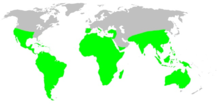
| |
Tarantulascomprise a group of large and often hairyspidersof thefamilyTheraphosidae.[2]As of December 2023[update],1,100specieshave been identified, with 166genera.[3]The term "tarantula" is usually used to describe members of the family Theraphosidae, although many other members of the same infraorder (Mygalomorphae) are commonly referred to as "tarantulas" or "false tarantulas". Some of the more common species have become popular in theexotic pettrade. ManyNew Worldspecies kept as pets havesetaeknown asurticating hairsthat can cause irritation to the skin, and in extreme cases, cause damage to the eyes.[4]
Overview
Like allarthropods,the tarantula is aninvertebratethat relies on anexoskeletonfor muscular support.[5]Like otherArachnida,a tarantula's body comprises two main parts, theprosoma(or cephalothorax) and theopisthosoma(or abdomen). The prosoma and opisthosoma are connected by thepedicel,orpregenital somite.This waist-like connecting piece is actually part of the prosoma and gives the opisthosoma a wide range of motion relative to the prosoma.
Depending on the species, the body length of tarantulas ranges from about5 to 11 cm (2 to4+1⁄2in)[6]with leg spans of 8–30 cm (3–12 in).[citation needed]Leg span is determined by measuring from the tip of the back leg to the tip of the front leg on the opposite side. Some of the largest species of tarantula may weigh over 85 g (3 oz); the largest of all, thegoliath birdeater(Theraphosa blondi) fromVenezuelaandBrazil,has been reported to attain a weight of 170 g (6 oz)[7]and a leg-span up to 30 cm (12 in), males being longer and females greater in girth. The fang size of this tarantula reaches a maximum of4 cm (1+1⁄2in).[7]
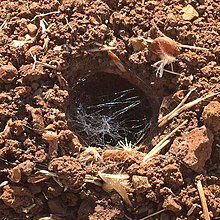
Theraphosa apophysis(the pinkfoot goliath) was described 187 years after the goliath birdeater, so its characteristics are not as well attested.T. blondiis generally thought to be the heaviest tarantula, andT. apophysishas the greatest leg span. Two other species,Lasiodora parahybana(the Brazilian salmon birdeater) andLasiodora klugi,rival the size of the two goliath spiders.

Most species ofNorth Americantarantulas are brown. Elsewhere, species have been found that variously display cobalt blue (Cyriopagopus lividus), black with white stripes (Aphonopelma seemanni), yellow leg markings (Eupalaestrus campestratus), metallic blue legs with vibrant orange abdomen and green prosoma (Chromatopelma cyaneopubescens). Their natural habitats includesavanna,grasslandsuch as in thepampas,rainforest,desert,scrubland,mountains,andcloud forest.They are generally classed among the terrestrial types. They are burrowers that live in the ground.
Tarantulas are becoming increasingly popular as pets and some species are readily available in captivity.
Identification
Tarantulas can be confused with other members of the orderMygalomorphae,such astrapdoor spiders,funnel-web spidersandpurseweb spiders.They can also be confused with some members of the orderAraneomorphaesuch as theLycosidaefamily. There are multiple ways to identify a tarantula. First the hairs: in theAmericasmost tarantulas haveurticating hairs,though some, such as theHemirrhagusgenus, lack these. The hairs are usually more noticeable than with most otherspiders.Another is the size, as tarantulas tend to be bigger, but this is again not a failproof way. They also do not use theirwebsfor hunting, instead using them as building material or tripwire.[8]
One of the most decisive ways to tell is by looking at their fangs. Tarantula fangs face downwards, as opposed to those oftrue spiders,which face each other, allowing them to make pincerlike motions. They also own twobook lungs,as opposed to true spiders which only have one. Their lifespan is also longer than most spiders.[8]
-
APhidippus johnsonijumping spider's fangs
-
ALasiodora parahybanatarantula's fangs

Etymology
The spider originally bearing the nametarantulawasLycosa tarantula,a species ofwolf spidernative to Mediterranean Europe.[9]The name is derived from the southernItaliantown ofTaranto.[10]The termtarantulawas subsequently applied to almost any large, unfamiliar species of ground-dwelling spider, in particular to theMygalomorphaeand especially theNew WorldTheraphosidae.Compared to tarantulas,wolf spidersare not particularly large or hairy, and so among English speakers in particular, usage eventually shifted in favour of the Theraphosidae, even though they are not closely related to wolf spiders at all, being in a differentinfraorder.
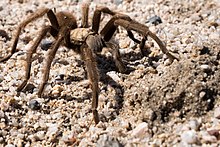
The nametarantulais also incorrectly applied to other large-bodied spiders, including thepurseweb spidersoratypical tarantulas,the funnel-webs (DipluridaeandHexathelidae), and thedwarf tarantulas.These spiders are related to tarantulas (all beingmygalomorphs) but fall into differentfamiliesfrom them.Huntsman spidersof the familySparassidaehave also been termedtarantulasbecause of their large size, when, in fact, they are not related. Instead, huntsman spiders belong to the infraorderAraneomorphae.
The elementpelmain genus names
Many theraphosid genera have names, either accepted orsynonymous,containing the elementpelma.This can be traced back toCarl Ludwig Kochin 1850,[11]who in describing his new genusEurypelmawrote, "Die Sammetbürste der Fussohlen sehr breit"(lit. 'the velvet-brush of the footsole very wide').[12]Germanarachnologistsuse the wordFußto refer to thetarsus(the last article of a spider's leg).[13]Translations ofSammetbürsteinto Latin use the wordscopula.[14]Hence in English arachnological terminology, Koch meant 'thescopulaof the base of the tarsus very wide'.Eury-is derived from theGreekeurýs(εὐρύϛ), meaning 'wide', whilepélma(πέλμα) means 'the sole of the foot',[11]paralleling Koch's use ofFußsohle(in modern spelling). ThusEurypelmaliterally means 'wide footsole'; however, arachnologists have conventionally takenpelmain such names to refer to the scopula, so producing the meaning 'with a wide scopula'.[11]
Other genus names or synonyms that Estrada-Alvarez and Cameron regard as having 'footsole' or 'scopula' meanings include:[11]
- Acanthopelma– Greekácantha(ἄκανθα) 'thorn, spine'; overall meaning 'spiny footsole'
- Brachypelma– Greekbrachýs(βραχύϛ) 'short'; overall meaning 'short scopula'
- Metriopelma– Greekmétrios(μέτριοϛ) 'of moderate size'; overall meaning 'medium length scopula'
- Schizopelma– from the Greek origin combining formschizo-(σχίζω) 'split'; overall meaning 'split footsole'
- Sericopelma– Greeksericós(σηρικόϛ) 'silky'; overall meaning 'silken scopula'
Later, particularly following genus names published byR.I. Pocockin 1901,[15]the elementpelmaappears to have become synonymous with 'theraphosid'. For example, the author ofCardiopelmawrites, "Cardiopelma fait réference aux genitalia de la femelle qui évoquent la forme d'un Coeur"('Cardiopelma refers to the female genitalia that evoke the shape of a heart'), with no reference to either 'footsole' or 'scopula'. Names interpreted in this way include:[11]
- Aphonopelma– Greekáphonos(ἄφωνοϛ) 'soundless'; overall meaning 'theraphosid without sound'
- Cardiopelma– Greekcardía(καρδία) 'heart'; overall meaning 'heart theraphosid' (referring to the heart-shaped female genitalia)
- Clavopelma– Latinclavis'club'; overall meaning 'theraphosid with club-shaped hairs'
- Delopelma– Greekdelós(δηλόϛ) 'clear, obvious, visible, conspicuous, plain'; overall meaning 'theraphosid without plumose hair'
- Gosipelma– the elementgosi-means 'desert', relating to theGosiute people;overall meaning 'desert theraphosid'
- Spelopelma– Greekspélaion(σπήλαιον) 'cave'; overall meaning 'cave theraphosid'
Distribution
Tarantulas of various species occur throughout theUnited States,Mexico,inCentral America,and throughoutSouth America.Other species occur variously throughoutAfrica,much ofAsia(including theRyukyu Islandsin southernJapan), and all ofAustralia.InEurope,some species occur inSpain,Portugal,Turkey,southernItaly,andCyprus.
Habits
Somegeneraof tarantulas hunt prey primarily in trees; others hunt on or near the ground. All tarantulas can producesilk;while arboreal species typically reside in a silken "tube tent",terrestrialspecies line theirburrowswith silk to stabilize theburrowwall and facilitate climbing up and down. Tarantulas mainly eat large insects and other arthropods such ascentipedes,millipedes,and otherspiders,using ambush as their primary method of prey capture. Armed with their massive, powerfulcheliceraetipped with long,chitinousfangs, tarantulas are well-adapted to killing other largearthropods.The biggest tarantulas sometimes kill and consume small vertebrates such aslizards,mice,bats,birds,and smallsnakes.
Appendages
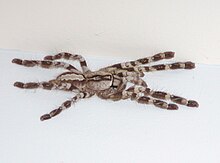
The eight legs, the two chelicerae with their fangs, and thepedipalpsare attached to theprosoma.Thecheliceraeare two double-segmented appendages located just below the eyes and directly forward of the mouth. The chelicerae contain thevenomglands that vent through the fangs. The fangs are hollow extensions of the chelicerae that inject venom into prey or animals that the tarantula bites in defense, and they are also used tomasticate.These fangs are articulated so that they can extend downward and outward in preparation to bite or can fold back toward thecheliceraeas a pocket knife blade folds back into its handle. The chelicerae of a tarantula completely contain the venom glands and the muscles that surround them, and can cause the venom to be forcefully injected into prey.
The pedipalpi are two six-segmented appendages connected to the prosoma near the mouth and protruding on either side of both chelicerae. In most species of tarantulas, the pedipalpi contain sharp, jagged plates used to cut and crush food often called thecoxaeormaxillae.As with other spiders, the terminal portions of the pedipalpi of males function as part of their reproductive system. Male spiders spin a silken platform (sperm web) on the ground onto which they releasesemenfrom glands in theiropisthosoma.Then they insert their pedipalps into the semen, absorb the semen into the pedipalps, and later insert the pedipalps (one at a time) into the reproductive organ of the female, which is located in her abdomen. The terminal segments of the pedipalps of male tarantulas are moderately larger in circumference than those of a female tarantula. Male tarantulas have specialspinneretssurrounding the genital opening. Silk for the sperm web of the tarantula is exuded from these special spinnerets.


A tarantula has four pairs of legs and two additional pairs of appendages. Each leg has seven segments, which from the prosoma out are: coxa, trochanter, femur, patella, tibia, tarsus and pretarsus, and claw. Two or three retractable claws at the end of each leg are used to grip surfaces for climbing. Also on the end of each leg, surrounding the claws, is a group of bristles, called the scopula, which help the tarantula to grip better when climbing surfaces such as glass. The fifth pair is the pedipalps, which aid in feeling, gripping prey, and mating in the case of a mature male. The sixth pair of appendages is the chelicerae and their attached fangs. When walking, a tarantula's first and third legs on one side move at the same time as the second and fourth legs on the other side of its body. The muscles in a tarantula's legs cause the legs to bend at the joints, but to extend a leg, the tarantula increases the pressure ofhaemolymphentering the leg.
Tarantulas, like almost all other spiders, have their primary spinnerets at the end of the opisthosoma. Unlike most spider species in the infraorderAraneomorphae,which includes the majority of extant spider species, and most of which have six, tarantula species have two or four spinnerets. Spinnerets are flexible, tube-like structures from which thespiderexudes its silk. The tip of each spinneret is called the spinning field. Each spinning field is covered by as many as 100 spinning tubes through which silk is exuded. As the silk is pulled out of the spinnerets, the shear forces cause proteins in the silk to crystallize, transforming it from a liquid to a solid thread.
Digestive system

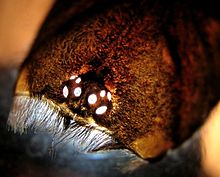
The tarantula's mouth is located under itscheliceraeon the lower front part of itsprosoma.The mouth is a short, straw-shaped opening that can only suck, meaning that anything taken into it must be in liquid form. Prey with large amounts of solid parts, such as mice, must be crushed and ground up or predigested, which is accomplished by coating the prey with digestive juices secreted from openings in thechelicerae.
The tarantula's digestive organ (stomach) is a tube that runs the length of its body. In theprosoma,this tube is wider and forms the sucking stomach. When the sucking stomach's powerful muscles contract, the stomach is increased in cross-section, creating a strong sucking action that permits the tarantula to suck its liquefied prey up through the mouth and into the intestines. Once the liquefied food enters the intestines, it is broken down into particles small enough to pass through the intestine walls into thehemolymph(blood stream), where it is distributed throughout the body. After feeding, the leftovers are formed into a small ball by the tarantula and thrown away. In a terrarium, they often put them into the same corner.[16]
Nervous system
A tarantula's central nervous system (brain) is located in the bottom of the innerprosoma.A tarantula perceives its surroundings primarily via sensory organs calledsetae(bristles or spines, sometimes referred to as hairs). Although a tarantula has eight eyes like mostspiders,touch is its keenest sense, and in hunting, it primarily depends on vibrations given off by the movements of its prey. A tarantula's setae are very sensitive organs and are used to sense chemical signatures, vibrations, wind direction, and possibly even sound. Tarantulas are also very responsive to the presence of certain chemicals such aspheromones.
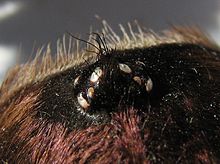
The eyes are located above the chelicerae on the forward part of the prosoma. They are small and usually set in two rows of four. Most tarantulas are not able to see much more than light, darkness, and motion. Arboreal tarantulas generally have better vision compared with terrestrial tarantulas.
Respiratory system
All types of tarantulas have two sets ofbook lungs(breathing organs); the first pair is located in a cavity inside the lower front part of the abdomen near where the abdomen connects to thecephalothorax,and the second pair is slightly farther back on the abdomen. Air enters the cavity through a tiny slit on each side of and near the front of the abdomen. Each lung consists of 15 or more thin sheets of folded tissue arranged like the pages of a book. These sheets of tissue are supplied by blood vessels. As air enters each lung, oxygen is taken into the blood stream through the blood vessels in the lungs. Needed moisture may also be absorbed from humid air by these organs.
Circulatory system

A tarantula's blood is unique (not only in appearance); an oxygen-transporting protein is present (the copper-basedhemocyanin), but not enclosed in blood cells such as the erythrocytes of mammals. A tarantula's blood is not true blood, but rather a liquid calledhemolymph(or haemolymph). At least four types ofhemocytes,or hemolymph cells, are known.
The tarantula's heart is a long, slender tube located along the top of theopisthosoma.The heart is neurogenic as opposed to myogenic, so nerve cells instead of muscle cells initiate and coordinate the heart. It pumps hemolymph to all parts of the body through open passages often referred to as sinuses, and not through a circular system of blood vessels. If theexoskeletonis breached, loss of hemolymph will kill the spider unless the wound is small enough that the hemolymph can dry and close it.
Predators
Despite their large size and fearsome appearance and reputation, tarantulas themselves are prey for many other animals. The most specialized of these predators are large members of the wasp familyPompilidaesuch as the waspHemipepsis ustulata.These wasps are called "tarantula hawks".The largest tarantula hawks, such as those in the genusPepsis,track, attack, and kill large tarantulas. They useolfactionto find the lair of a tarantula. The wasp must deliver a sting to the underside of the spider's cephalothorax, exploiting the thin membrane between the basal leg segments. This paralyzes the spider, and the wasp then drags it back into its burrow before depositing an egg on the prey's abdomen. The wasp then seals the spider in its burrow and flies off to search for more hosts. The wasp egg hatches into a larva and feeds on the spider's inessential parts, and as it approaches pupation, it consumes the remainder.[17]Other arthropods, such as large scorpions andgiant centipedes,are also known to prey on tarantulas.[18]
Tarantulas are also preyed upon by a wide variety of vertebrates. Many of these, including lizards, frogs, birds, snakes and mammals, are generalist predators of all kinds of large arthropods. Mammals that have been known to prey on tarantulas, such as thecoati,kinkajou,andopossumin theNew World,andmongoosesand thehoney badgerin theOld World,are often immune to the venom of their arthropod prey.
Humans also consume tarantulas for food in their native ranges. They are considered a delicacy in certain cultures (e.g. Venezuela[19]and Cambodia). They can be roasted over an open fire to remove the bristles (described further below) and then eaten.

Tarantulas have evolved specialized bristles, orsetae,to defend themselves against predators. Besides the normal bristles covering the body, some tarantulas also have a dense covering of irritating bristles calledurticating hairs,on theopisthosoma,that they sometimes use as protection against enemies.[20]These bristles are present on most New World species, but not on any specimens from the Old World. Urticating hairs are usually kicked off the abdomen by the tarantula, but some may simply rub the abdomen against the target, like the genusAvicularia.These fine bristles are barbed and serve to irritate. They can be lethal to small animals such as rodents. Some people are sensitive to these bristles, and develop serious itching and rashes at the site. Exposure of the eyes and respiratory system to urticating hairs should be strictly avoided. Species with urticating hairs can kick these bristles off; they are flicked into the air at a target using their back pairs of legs. Tarantulas also use these bristles for other purposes, such as to mark territory or to line their shelters (the latter such practice may discouragefliesfrom feeding on the spiderlings). Urticating hairs do not grow back, but are replaced with eachmolt.The intensity, number, and flotation of the bristles depends on the species of tarantula.
To predators and other enemies, these bristles can range from being lethal to simply being a deterrent. With humans, they can cause irritation to eyes, nose, and skin, and more dangerously, the lungs and airways, if inhaled. The symptoms range from species to species, from person to person, from a burning itch to a minor rash. In some cases, tarantula bristles have caused permanent damage to human eyes.[4]
Some setae are used tostridulate,which makes a hissing sound. These bristles are usually found on the chelicerae. Stridulation seems to be more common in Old World species.
Bites and urticating bristles

All tarantulas are venomous. Although theirvenomis not deadly to humans, some bites cause serious discomfort that might persist for several days. In general, the effects of the bites of all kinds of tarantula are not well known. While the bites of many species are known to be no worse than a wasp sting, accounts of bites by some species are reported to be very painful and to produce intense spasms that may recur over a period of several days; thevenomof the African tarantulaPelinobius muticusalso causes strong hallucinations.[21][need quotation to verify][additional citation(s) needed]ForPoecilotheriaspecies, researchers have described more than 20 bites with the delayed onset of severe and diffuse muscle cramps, lasting for several days, that in most cases resolved completely with the use ofbenzodiazepinesandmagnesium.In all cases, seeking medical aid is advised. Because other proteins are included when atoxinis injected, some individuals may suffer severe symptoms due to anallergic reactionrather than to the venom. Such allergic effects can be life-threatening.[citation needed]Additionally, the large fangs of a tarantula can inflict painfulpuncture wounds,which can lead to secondarybacterial infectionsif not properly treated.
Before biting, a tarantula may signal its intention to attack by rearing up into a "threat posture", which may involve raising its prosoma and lifting its front legs into the air, spreading and extending its fangs, and (in certain species) making a loud hissing bystridulating.Tarantulas often hold this position for longer than the duration of the original threat. Their next step, without biting, may be to slap down on the intruder with their raised front legs. If that response fails to deter the attacker, the tarantulas of the Americas may next turn away and flickurticating hairstoward the pursuing predator. The next response may be to leave the scene entirely, but especially if no line of retreat is available, their final response may also be to whirl suddenly and bite. Some tarantulas are well known to give "dry bites", i.e., they may defensively bite some animal that intrudes on their space and threatens them, but they do not pumpvenominto the wound.
New-world tarantulas—those indigenous to the Americas—have bites that generally pose little threat to humans (other than causing localized pain). Most of them are equipped withurticating hairson their abdomens, and almost always throw these barbed bristles as the first line of defense. These bristles irritate sensitive areas of the body and especially seem to target curious animals that may sniff these bristles into the mucous membranes of the nose. Some species have more effectiveurticating bristlesthan others. Thegoliath birdeateris known for its particularly irritatingurticating bristles.They can penetrate thecornea,so eye protection should be worn when handling such tarantulas.[22]
Old Worldtarantulas have nourticating bristlesand are more likely to attack when disturbed. They often have more potent, medically significantvenom,and are faster and much more nervous and defensive thanNew Worldspecies.
Some dangerous spider species are related to tarantulas and are frequently confused with them. A popularurban legendmaintains that deadly varieties of tarantula exist somewhere inSouth America.This claim is often made without identifying a particular spider, although the "banana tarantula" is sometimes named. A likely candidate for the true identity of this spider is the dangerousBrazilian wandering spider(Phoneutria fera) of the familyCtenidae,as it is sometimes found hiding in clusters of bananas and is one of several spiders called "banana spiders". It is not technically a tarantula, but it is fairly large (4- to 5-inch legspan), somewhat ″hairy″, and is highlyvenomousto humans. Another dangerous type ofspidersthat have been confused with tarantulas are theAustralian funnel-web spiders.The best known species of these is theSydney funnel-web spider(Atrax robustus) aspiderthat is aggressive, highlyvenomous,and (prior to the development ofantivenomin the 1980s) was responsible for numerous deaths inAustralia.Thesespidersare members of the same infraorder as tarantulas,Mygalomorphae.Some Australians use the slang term "triantelope" (a corruption of the incorrect term tarantula, which is also used) for large, ″hairy″, and harmless members of thehuntsman spiderfamily, which are often found on interior household walls and in automobiles.[23]
Sexual dimorphism
Some tarantula species exhibit pronouncedsexual dimorphism.Males tend to be smaller (especially their abdomens, which can appear quite narrow) and may be dull in color when compared to their female counterparts, as in the speciesHaplopelma lividum.Mature male tarantulas also may have tibial hooks on their front legs, which are used to restrain the female's fangs during copulation. Males typically have longer legs than the females.

A juvenile male's sex can be determined by looking at a castexuviaforepiandrous fusillaeorspermathecae.Females possessspermathecae,except for the speciesSickius longibulbiandEncyocratella olivacea.[24][25]Males have much shorter lifespans than females because they die relatively soon after maturing. Few live long enough for a postultimatemolt,which is unlikely in natural habitats because they are vulnerable to predation, but has happened in captivity, though rarely. Most males do not live through thismolt,as they tend to get their emboli, mature male sexual organs onpedipalps,stuck in themolt.Most tarantula fanciers regard females as more desirable as pets due to their much longer lifespans. Wild-caught tarantulas are often mature males because they wander out in the open and are more likely to be caught.
Life cycle
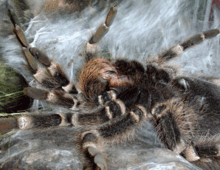
Like other spiders, tarantulas have to shed theirexoskeletonperiodically as they grow, a process calledmolting.A young tarantula may do this several times a year as a part of the maturation process, while full-grown specimens only molt once a year or less, or sooner, to replace lost limbs or losturticating hairs.It is visibly apparent that molting is imminent when theexoskeletontakes on a darker shade. If a tarantula previously used its urticating hairs, the bald patch turns from a peach color to deep blue. The tarantula also stops feeding and becomes more lethargic during this time.
While most Tarantulas species take between two and five years to reach sexual maturity, some species can take up to 10 years. Upon reaching adulthood, males typically have an 18-month period left to live so immediately go in search of a female mate. Although females continue to molt after reaching maturity, males rarely do again once they reach adulthood. Those that do often can become stuck during the molting process due to their sexual organs and die.
Females can live for 30 to 40 years.[26]Grammostola roseaspiders, which eat once or twice a week, have lived up to 20 years in captivity.[27]Some have survived on water alone for up to two years.[26]
Reproduction

After reaching sexual maturity, a female tarantula normally mates and lays eggs once per year,[28][29]although they do not always do so.[30]
As with other spiders, the mechanics of intercourse are quite different from those ofmammals.Once a male spider reaches maturity and becomes motivated to mate, he weaves a web mat on a flat surface. The spider then rubs his abdomen on the surface of this mat, and in so doing, releases a quantity of semen. He may then insert hispedipalps(short, leg-like appendages between thecheliceraeand front legs) into the pool of semen. The pedipalps absorb the semen and keep it viable until a mate can be found. When a male spider detects the presence of a female, the two exchange signals to establish that they are of the same species. These signals may also lull the female into a receptive state. If the female is receptive, then the male approaches her and inserts his pedipalps into an opening in the lower surface of her abdomen, theopisthosoma.After the semen has been transferred to the receptive female's body, the male swiftly leaves the scene before the female recovers her appetite. Although females may show some aggression after mating, the male rarely becomes a meal.[citation needed][9]
Females deposit 50 to 2,000 eggs, depending on the species, in a silkenegg sacand guard it for six to eight weeks. During this time, the females stay very close to the egg sacs and become more aggressive. Within most species, the females turn the egg sac often, which is called brooding. This keeps the eggs from deforming due to sitting in one position too long. The young spiderlings remain in the nest for some time after hatching, where they live off the remains of their yolk sacs before dispersing.[citation needed][31]
Taxonomy
Linnaeusplaced all spiders in a single genus,Aranea.In 1802,Charles Athanase Walckenaerseparated mygalomorph spiders into a separate genus,Mygale,leaving all otherspidersinAranea.However,Mygalehad already been used in 1800 byGeorges Cuvierfor a genus of mammals (inGreek,mygalemeans "shrew"). Accordingly, in 1869,Tamerlan Thorellused the family name "Theraphosoidae" (modern Theraphosidae) for themygalomorphspiders known to him, rather than "Mygalidae" (as used, for example, byJohn Blackwall). Thorell later split the family into a number of genera, includingTheraphosa.[32][33]
Subfamilies
A 2019phylogenomicstudy recognized 12 subfamilies, one (Ischnocolinae) known not to bemonophyletic.[34]
The relationship between the subfamilies found in the study is shown in the followingcladogram.[34]The dual placing of Ischnocolinae is highlighted.
| Theraphosidae | |
All the species that possessurticating hairsand have been seen to use them in bombardment behavior are placed in the "bombardier clade", although not all species in the included subfamilies possess such hairs (allSchismatothelinaelack them as do mostPsalmopoeinaegenera). It is not clear whether the possession ofurticating hairswas an ancestral trait of the clade, and has been lost in some species, or whether it represents multiple gains. Foleyet al.suggested that the second hypothesis appeared to be better supported.[34]
Other subfamilies that have been recognized include:[citation needed]
- Acanthopelminae– may be treated as synonymous with Ischnocolinae
- Selenogyrinae
- Spelopelminae– typically not accepted,Hemirrhagusbeing treated as Theraphosinae
Genera
As of December 2023[update],theWorld Spider Catalogaccepted the following genera:[1]
- Abd Omega phobemaSherwood, Gabriel, Peñaherrera-R., Léon-E., Cisneros-Heredia, Brescovit & Lucas, 2023
- AcanthopelmaF. O. Pickard-Cambridge, 1897– Guyana
- AcanthoscurriaAusserer, 1871– South America, Guatemala
- AcentropelmaPocock, 1901– Belize, Mexico, Guatemala
- A Enigma rachneSchmidt, 2005– Costa Rica
- AgnostopelmaPérez-Miles & Weinmann, 2010– Colombia
- AguapanelaPerafán & Cifuentes, 2015
- AmazoniusCifuentes & Bertani, 2022- South America
- AnnandaliellaHirst, 1909– India
- AnoploscelusPocock, 1897– Uganda, Tanzania, Rwanda
- AnqashaSherwood & Gabriel, 2022- Peru
- AntikunaKaderka, Ferretti, West, Lüddecke & Hüsser, 2021- Peru
- AntillenaBertani, Huff & Fukushima, 2017– Dominican Republic
- AphonopelmaPocock, 1901– North America, Central America
- AugacephalusGallon, 2002– South Africa, Mozambique, Eswatini
- AviculariaLamarck, 1818– South America, Trinidad and Tobago, Panama
- BacillochilusGallon, 2010– Angola
- BatesiellaPocock, 1903– Cameroon
- BermejoaGabriel, Sherwood & Pérez-Miles, 2023
- BirupesGabriel & Sherwood, 2019– Malaysia
- BistriopelmaKaderka, 2015– Peru
- BonnetinaVol, 2000– Mexico
- BrachionopusPocock, 1897– South Africa
- BrachypelmaSimon, 1891– Mexico, Costa Rica, Guatemala
- BumbaPérez-Miles, Bonaldo & Miglio, 2014– Brazil, Venezuela, Ecuador
- CardiopelmaVol, 1999– Unknown
- CaribenaFukushima & Bertani, 2017– Cuba
- CatandubaYamamoto, Lucas & Brescovit, 2012– Brazil
- CatumiriGuadanucci, 2004– South America
- CeratogyrusPocock, 1897– Africa
- ChaetopelmaAusserer, 1871– Asia, Greece, Africa
- ChilobrachysKarsch, 1892– Asia
- ChinchaysuyuFerretti, Chaparro, Ochoa & West, 2023
- ChromatopelmaSchmidt, 1995– Venezuela
- CitharacanthusPocock, 1901– Cuba, Central America, Mexico
- CitharognathusPocock, 1895– Indonesia
- ClavopelmaChamberlin, 1940– Mexico
- CoremiocnemisSimon, 1892– Malaysia, Indonesia, Australia
- CotztetlanaMendoza, 2012– Mexico
- CrassicrusReichling & West, 1996– Mexico, Belize
- CubananaOrtiz, 2008– Cuba
- CyclosternumAusserer, 1871– South America, Mexico, Costa Rica
- CymbiapophysaGabriel & Sherwood, 2020
- CyriocosmusSimon, 1903– South America, Trinidad and Tobago
- CyriopagopusSimon, 1887– Asia
- CyrtogrammommaPocock, 1895- Guyana and Brazil
- CyrtopholisSimon, 1892– Caribbean
- DavusO. Pickard-Cambridge, 1892– Central America, Mexico
- DolichotheleMello-Leitão, 1923– Brazil, Bolivia
- DugesiellaPocock, 1901- Mexico
- EncyocratellaStrand, 1907– Tanzania
- EncyocratesSimon, 1892– Madagascar
- EphebopusSimon, 1892– Suriname, Brazil
- EuathlusAusserer, 1875– Chile, Argentina
- EucratoscelusPocock, 1898– Kenya, Tanzania
- EumenophorusPocock, 1897– Sierra Leone
- EupalaestrusPocock, 1901– South America
- EuphrictusHirst, 1908– Cameroon, Congo
- EuthycaelusSimon, 1889– Colombia, Venezuela
- GrammostolaSimon, 1892– South America
- GuyruitaGuadanucci, Lucas, Indicatti & Yamamoto, 2007– Brazil, Venezuela
- HapalopusAusserer, 1875– South America, Panama
- HapalotremusSimon, 1903– Bolivia, Peru, Argentina
- HaploclastusSimon, 1892– India
- HaplocosmiaSchmidt & von Wirth, 1996– Nepal
- HarpactiraAusserer, 1871– South Africa, Namibia
- HarpactirellaPurcell, 1902– South Africa, Morocco
- HemirrhagusSimon, 1903– Mexico
- HeterophrictusPocock, 1900– India
- HeteroscodraPocock, 1900– Cameroon, Gabon, Congo
- HeterotheleKarsch, 1879– Africa, Argentina
- HolotheleKarsch, 1879– Caribbean, South America
- HomoeommaAusserer, 1871– South America
- HysterocratesSimon, 1892– Africa
- IdiotheleHewitt, 1919– South Africa
- IridopelmaPocock, 1901– Brazil
- IschnocolusAusserer, 1871– Africa, Asia, Brazil, Europe
- IsiboroaGabriel, Sherwood & Pérez-Miles, 2023
- KankuamoPerafán, Galvis & Pérez-Miles, 2016
- KochianaFukushima, Nagahama & Bertani, 2008– Brazil
- LampropelmaSimon, 1892– Indonesia, Malaysia, Singapore
- LasiocyanoGalleti-Lima, Hamilton, Borges & Guadanucci, 2023– Brazil
- LasiodoraC. L. Koch, 1850– South America, Costa Rica
- LasiodoridesSchmidt & Bischoff, 1997– Ecuador, Peru
- LongilyraGabriel, 2014– El Salvador
- LoxomphaliaSimon, 1889– Tanzania
- LoxoptygusSimon, 1903– Ethiopia
- LyrognathusPocock, 1895– Indonesia, India, Malaysia
- MagnacarinaMendoza, Locht, Kaderka, Medina & Pérez-Miles, 2016– Mexico
- MascaraneusGallon, 2005– Mauritius
- MegaphobemaPocock, 1901– Costa Rica, Colombia, Ecuador
- MelloinaBrignoli, 1985– Panama, Venezuela
- MelognathusChamberlin, 1917
- MetriopelmaBecker, 1878– Mexico
- MiaschistopusPocock, 1897– Venezuela
- MonocentropusPocock, 1897– Yemen, Madagascar
- MundurukuMiglio, Bonaldo & Pérez-Miles, 2013
- MurphyarachneSherwood & Gabriel, 2022- Peru
- MygalarachneAusserer, 1871– Honduras
- MyostolaSimon, 1903– Gabon, Cameroon
- NeischnocolusPetrunkevitch, 1925– Panama
- NeoheterophrictusSiliwal & Raven, 2012– India
- NeoholotheleGuadanucci & Weinmann, 2015– Colombia, Trinidad and Tobago, Venezuela
- NeostenotarsusPribik & Weinmann, 2004– French Guiana
- NesiergusSimon, 1903– Seychelles
- NesipelmaSchmidt & Kovařík, 1996– St. Kitts and Nevis
- NhanduLucas, 1983– Brazil, Paraguay
- OmothymusThorell, 1891– Malaysia
- OrnithoctonusPocock, 1892– Myanmar, Thailand
- OrphnaecusSimon, 1892– Papua New Guinea, Philippines
- OzopactusSimon, 1889– Venezuela
- PachistopelmaPocock, 1901– Brazil
- PamphobeteusPocock, 1901– South America, Panama
- ParvicarinaGalleti-Lima, Hamilton, Borges & Guadanucci, 2023
- PelinobiusKarsch, 1885– Kenya, Tanzania
- PhlogiellusPocock, 1897– Asia, Papua New Guinea
- PhoneyusaKarsch, 1884– Africa
- PhormictopusPocock, 1901– Cuba, Argentina, Brazil
- PhormingochilusPocock, 1895– Indonesia
- PhrixotrichusSimon, 1889– Chile, Argentina
- PlesiopelmaPocock, 1901– South America
- PlesiophrictusPocock, 1899– India, Micronesia, Sri Lanka
- PoecilotheriaSimon, 1885– Sri Lanka, India
- ProshapalopusMello-Leitão, 1923– Brazil, Colombia
- PsalistopsSimon, 1889- Colombia and Venezuela
- PsalmopoeusPocock, 1895– Trinidad, South America, Central America, Mexico
- PsednocnemisWest, Nunn & Hogg, 2012– Malaysia, Indonesia
- PseudhapalopusStrand, 1907– South America, Trinidad
- PseudoschizopelmaSmith, 1995- Mexico
- PterinochilusPocock, 1897– Africa
- PterinopelmaPocock, 1901– Brazil
- ReichlingiaRudloff, 2001– Belize
- ReversopelmaSchmidt, 2001– Ecuador or Peru
- SahydroaraneusMirza & Sanap, 2014– India
- SandinistaLonghorn & Gabriel, 2019
- SchismatotheleKarsch, 1879– Venezuela, Colombia
- SchizopelmaF. O. Pickard-Cambridge, 1897– Mexico
- ScopelobatesSimon, 1903– Dominican Republic
- SelenocosmiaAusserer, 1871– Oceania, Asia
- SelenogyrusPocock, 1897– Côte d'Ivoire, Sierra Leone
- SelenotholusHogg, 1902– Australia
- SelenotypusPocock, 1895– Australia
- SericopelmaAusserer, 1875– Central America, Brazil, Mexico
- SickiusSoares & Camargo, 1948– Brazil
- SphaerobothriaKarsch, 1879– Costa Rica, Panama
- SpinosatibiapalpusGabriel & Sherwood, 2020
- StichoplastorisRudloff, 1997– El Salvador, Costa Rica, Panama
- StromatopelmaKarsch, 1881– Africa
- TaksinusSongsangchote, Sippawat, Khaikaew & Chomphuphuang, 2022- Thailand
- TapinaucheniusAusserer, 1871– South America, Saint Vincent and the Grenadines
- TekoaporaGalleti-Lima, Hamilton, Borges & Guadanucci, 2023
- ThalerommataAusserer, 1875— Colombia, Mexico
- TheraphosaThorell, 1870– South America
- ThrigmopoeusPocock, 1899– India
- ThrixopelmaSchmidt, 1994– Peru, Chile
- Tliltocatl- Mexico, Costa Rica, Guatemala
- TmesiphantesSimon, 1892– Brazil
- TrichognathellaGallon, 2004– South Africa
- TrichopelmaSimon, 1888– Caribbean, South America, Central America
- TyphochlaenaC. L. Koch, 1850– Brazil
- UmbyquyraGargiulo, Brescovit & Lucas, 2018– Bolivia, Brazil
- UrupelmaKaderka, Lüddecke, Řezáč, Řezáčová & Hüsser, 2023
- VitaliusLucas, Silva & Bertani, 1993– Brazil, Argentina
- XenesthisSimon, 1891– Panama, Venezuela, Colombia
- YanomamiusBertani & Almeida, 2021– Brazil, Venezuela
- YbyraporaFukushima & Bertani, 2017– Brazil
Former genera:
- AmiPérez-Miles, 2008→Neischnocolus
- BarropelmaChamberlin, 1940→Neischnocolus
- EurypelmellaStrand, 1907,nomen dubium
- MagullaSimon, 1892→Tmesiphantes
- MelloleitaoinaGerschman & Schiapelli, 1960→Tmesiphantes
Fossil record
Fossils ofmygalomorphspiders date back to theTriassic.[citation needed]One species assigned to the Theraphosidae isProtertheraphosa spinipes,found inBurmese amber,which is dated to the mid and late Cretaceous.[35]
See also
References
- ^ab"Family: Theraphosidae Thorell, 1869".World Spider Catalog.Natural History Museum Bern.Retrieved2 May2022.
- ^Shultz, Stanley; Shultz, Marguerite (2009).The Tarantula Keeper's Guide.Hauppauge, New York: Barron's. p. 28.ISBN978-0-7641-3885-0.
- ^"Currently valid spider genera and species",World Spider Catalog,Natural History Museum Bern,retrieved20 August2022
- ^abBlaikie, Andrew J; John Ellis; Roshini Sanders; Caroline J. MacEwen (24 May 1997)."Eye disease associated with handling pet tarantulas: three case reports".BMJ.314(7093): 1524–5.doi:10.1136/bmj.314.7093.1524.PMC2126783.PMID9183200.
- ^Pomeroy, R. (2014, February 4). Pub. Real Clear Science, "Spiders, and Their Amazing Hydraulic Legs and Genitalia". Retrieved October 13, 2019, fromhttps:// realclearscience /blog/2013/02/spiders-their-amazing-hydraulic-legs-and-genitals.html.
- ^Jovan, Dennis, Kj, & Kenneth. (2019, May 1). Theraphosa blondi. Retrieved October 13, 2019, fromhttps:// theraphosidae.be/en/theraphosa-blondi/Archived18 May 2021 at theWayback Machine.
- ^abLewis, Tanya (17 October 2014)."Goliath Encounter: Puppy-Sized Spider Surprises Scientist in Rainforest".LiveScience.Live Science.Archivedfrom the original on 4 December 2014.Retrieved29 November2014.
- ^ab"Tarantula vs Other Spiders – 7 Key Differences – Fauna Facts".Retrieved15 July2022.
- ^abFabre, Jean-Henri; Translated by Alexander Teixeira de Mattos (1916)The Life of the spider,Dodd, Mead, New York.
- ^"Taranto".lifeinitaly.Archivedfrom the original on 4 September 2015.Retrieved29 August2015.
- ^abcdeEstrada-Alvarez, Julio C. & Cameron, H.D. (2012)."Etymological origins of the generic names of Mexican tarantulas (Araneae:Theraphosidae)".Revista Ibérica de Aracnología(21): 153–160.Retrieved10 October2019.
- ^Koch, C.L. (1850).Übersicht des Arachnidensystems, Heft 5(in German). Nürnberg: J.L. Lotzbeck. p. 73.doi:10.5962/bhl.title.39561.
- ^Foelix, Rainer F. (1992).Biologie der Spinnen(in German). Stuttgart: Georg Thieme. p. 17.ISBN3-13-575802-8.
- ^Schmerler, Johann Adam (1794).Lateinisch-deutsches und deutsch lateinisches Wörterbuch 3. Aufl, Volume 2(in German and Latin). Erlangen: J.J. Palm. p. 2402.OCLC669374426.Retrieved10 October2019.
- ^Pocock, R.I. (1901)."Some new and old genera of S.-American Avicularidae".Annals and Magazine of Natural History.7th Series.8(48): 540–555.doi:10.1080/03745480109443359.
- ^Kovařík, F (2001),Chov sklípkanů(Keeping Tarantulas); Madagaskar,Jihlava,p. 23
- ^Piper, R (2007)Extraordinary Animals: An Encyclopedia of Curious and Unusual Animals,Greenwood Press,ISBN0313339228.
- ^"Wild or Giant Centipedes versus Other Predators".howtogetridofhousecentipedes.Archivedfrom the original on 4 March 2016.Retrieved29 August2015.
- ^Murton, Willow."Tarantula kebab anyone?".BBC Food Blog, with video fromHuman Planet.BBC.Archivedfrom the original on 6 December 2011.Retrieved7 December2011.
- ^Cooke, J.A.L.; Roth, V.D.; Miller, F.H. (1972). "The urticating hairs of theraphosid spiders".American Museum Novitates:2498.hdl:2246/2705.
- ^Klátil, Lubomír (1998).Sklípkani: krasavci s chlupatýma nohama.Nakl. Kabourek Zlín. p. 40.ISBN978-80-901466-5-5.Archivedfrom the original on 31 December 2013.
- ^Tarantula shoots sharp bristles into owner's eyeNBC News/LiveScience
- ^Huntsman SpidersArchived12 July 2009 at theWayback Machineat The Australian Wonder Book of Knowledge
- ^Bertani, R.;Fukushima, C.S.; Júnior, P.I.S. (2008)."Mating behavior of Sickius longibulbi (Araneae, Theraphosidae, Ischnocolinae), a spider that lacks spermathecae"(PDF).The Journal of Arachnology.36(2): 331–335.doi:10.1636/CSt07-100.1.S2CID55978068.
- ^Gallon, R. C. (2003)."A new African arboreal genus and species of theraphosid spider (Araneae, Theraphosidae, Stromatopelminae) which lacks spermathecae"(PDF).Bulletin of the British Arachnological Society.12(9): 405–411.
- ^abSchultz, Stanley A.; Schultz, Marguerite J. (1998).The Tarantula Keeper's Guide.Barron's Educational Series. p. 75.ISBN0764100769.
- ^Animal-World."Rose-haired Tarantula".Animal World.Archivedfrom the original on 11 January 2017.Retrieved13 February2017.
- ^Ferretti, Nelson; Pérez-Miles, Fernando; González, Alda (13 May 2014). "Historical relationships among Argentinean biogeographic provinces based on mygalomorph spider distribution data (Araneae: Mygalomorphae)".Studies on Neotropical Fauna and Environment.49(1): 2.Bibcode:2014SNFE...49....1F.doi:10.1080/01650521.2014.903616.hdl:11336/33878.S2CID85259715.
Mygalomorph spiders are well-suited models for biogeographical analysis... They are long-lived and univoltine, and show high local endemicity.
- ^Punzo, Fred (2007).Spiders: Biology, Ecology, Natural History, and Behaviour.Brill. p. 182.ISBN9789004156647.
- ^Punzo, Fred (1999). "Aspects of the natural history and behavioural ecology of the tarantula spiderAphonopelma hentzi(Girard, 1854) (Orthognatha, Theraphosidae) ".Bulletin of the British Arachnological Society.11(4): 122.
- ^"Tarantula Facts".Live Science.Archivedfrom the original on 13 February 2017.Retrieved13 February2017.
- ^Thorell, T. (1869), "On European spiders. Part I. Review of the European genera of spiders, preceded by some observations on zoological nomenclature",Nova Acta Regiae Societatis Scientiarum Upsaliensis,Series 3,7:1–108
- ^Thorell, T. (1870), "On European spiders",Nova Acta Regiae Societatis Scientiarum Upsaliensis,Series 3,7:109–242
- ^abcFoley, Saoirse; Lüddecke, Tim; Cheng, Dong-Qiang; Krehenwinkel, Henrik; Künzel, Sven; Longhorn, Stuart J.; Wendt, Ingo; von Wirth, Volker; Tänzler, Rene; Vences, Miguel & Piel, William H. (2019). "Tarantula phylogenomics: A robust phylogeny of deep theraphosid clades inferred from transcriptome data sheds light on the prickly issue of urticating setae evolution".Molecular Phylogenetics and Evolution.140(106573): 106573.doi:10.1016/j.ympev.2019.106573.PMID31374259.S2CID199389268.
- ^Wunderlich, J.; Müller, Patrick (2020)."New and already described fossil spiders (Araneae) of 20 families in mid and late Cretaceous Burmese amber with notes on spider phylogeny, evolution and classification"(PDF).Beiträge zur Araneologie.13:22–164.Retrieved28 March2024.pp. 43–45.
Further reading
- S. B. Reichling & R. C. West (1996)."A new genus and species of theraphosid spider from Belize (Araneae, Theraphosidae)"(PDF).Journal of Arachnology.24:254–261.
- Raven R. R.(2005)."A new tarantula species from northern Australia (Araneae, Theraphosidae)"(PDF).Zootaxa.1004:15–28.doi:10.11646/zootaxa.1004.1.2.
External links
- TarantulaForum
- TarantulasatCurlie
- Tarantulas US ForumArchived28 February 2014 at theWayback Machine
- Word of the Day: Tarantula and Tarantella,etymology and folklore
- Overview of Species Information for All Named Theraphosidae Divided by SubfamilyArchived25 February 2021 at theWayback Machine
- Listing of all currently named Theraphosidae
- American Tarantula Society Headquarters
- Amazing Tarantulas
- NMSU Entomology Plant Pathology & Weed Science."The Spiders of the Arid Southwest".Retrieved15 July2013.
- Watch Tarantula (Theraphosidae) video clips from the BBC archive on Wildlife Finder
- Theraphosidae Belgium, everything about bird eaters[permanent dead link]
- [1]


